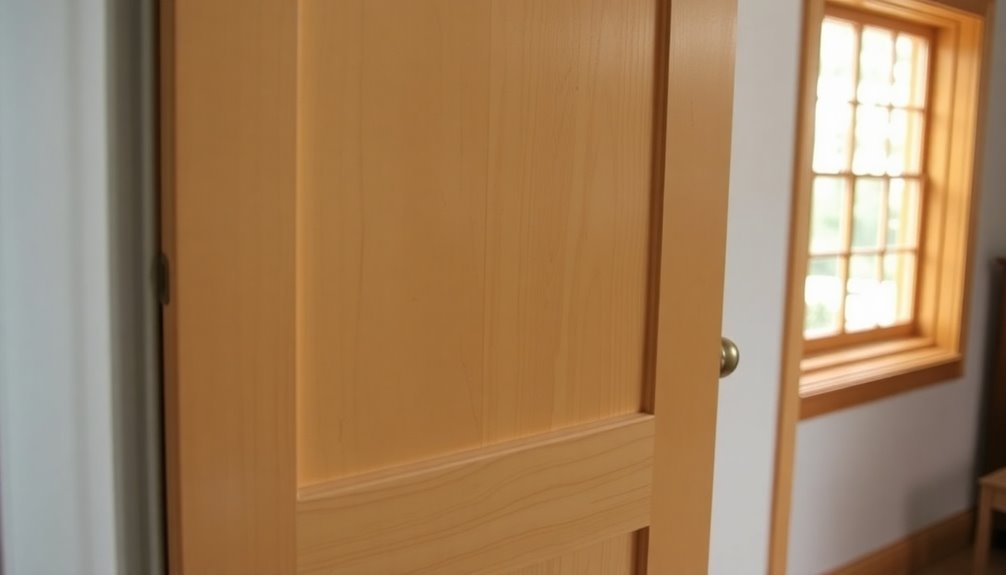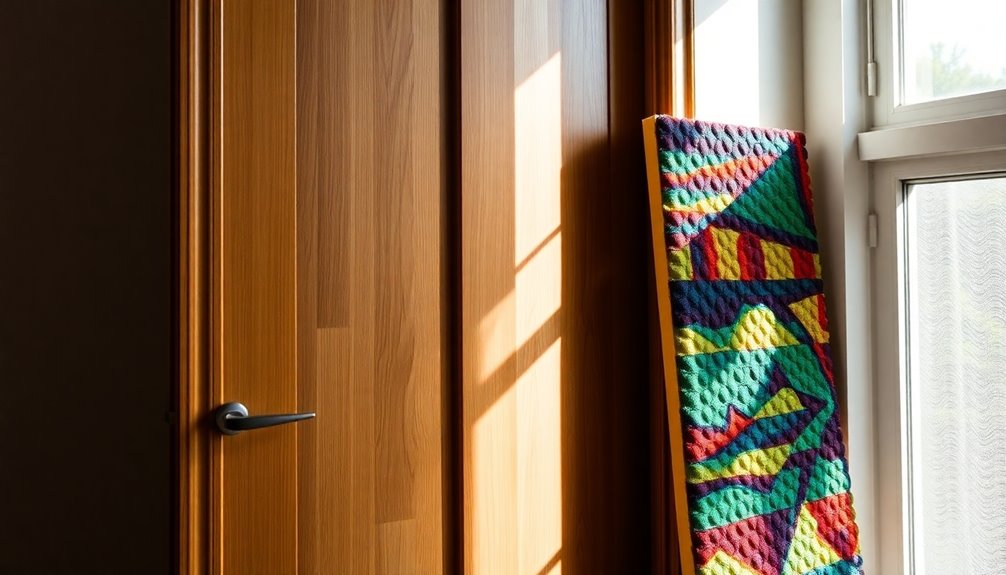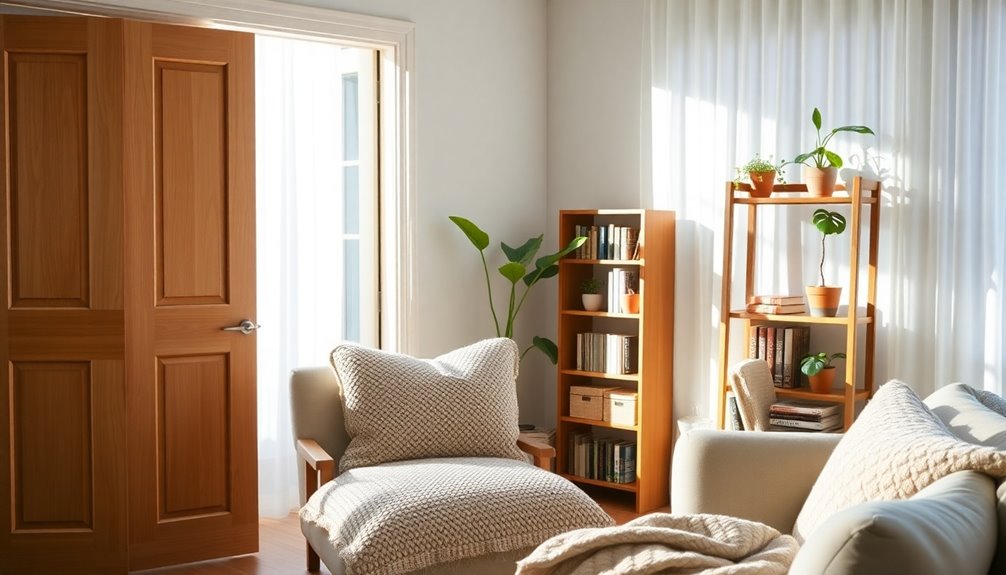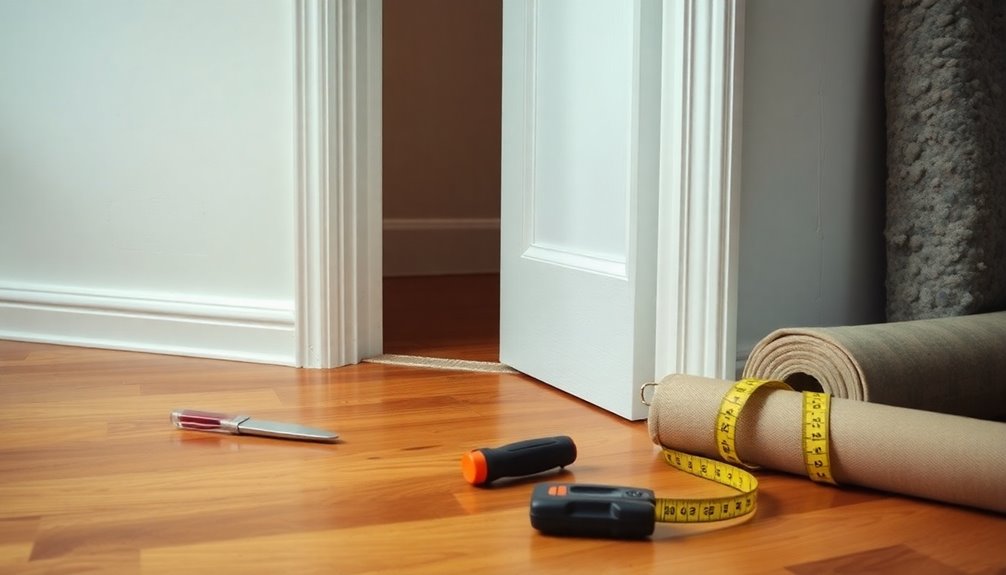Soundproofing a pocket door can be easy and affordable with some smart fixes. Start by sealing any gaps with closed cell foam tape or acoustic caulking to block noise from sneaking in. You can also hang heavy curtains or add a door sweep to absorb sound. For better results, consider using Mass Loaded Vinyl for extra density or filling the hollow core with Rockwool insulation. Arranging furniture strategically, like placing a bookshelf against the door, can further dampen sound. There's plenty more you can do to enhance your space's tranquility, so keep exploring your options.
Understanding Pocket Doors
Pocket doors are unique sliding doors that seamlessly disappear into the wall when opened, making them a stylish choice for saving space. However, if you're facing noise coming from adjacent rooms, it's crucial to understand their design and limitations.
Most pocket doors operate on a track system and don't use hinges, which allows for that smooth, space-saving functionality. Unfortunately, many are made from hollow core materials, which considerably reduces their sound-blocking capabilities compared to solid core doors. In fact, many businesses utilize expense management apps to streamline their financial oversight, ensuring that they can allocate resources effectively for home improvements. Balancing savings and investments is also important when planning for renovations.
You might notice gaps and cracks around the edges, especially at the bottom, which can let unwanted noise seep through easily. While standard pocket doors often lack soundproofing features, there are ways to enhance their effectiveness.
To improve sound insulation, consider proper sealing and treatment of your pocket door. If you're looking for a more robust solution, specialized soundproof pocket doors do exist, but many existing models require additional soundproofing measures. Additionally, utilizing cost-effective tools can help manage expenses related to upgrading your soundproofing options.
Common Soundproofing Challenges
When soundproofing a pocket door, you'll run into some common challenges.
The gaps around the door and its hollow core make it tough to block noise effectively. Additionally, budget apps can help you track expenses related to soundproofing materials and solutions. Plus, you'll need to evaluate material limitations and explore solutions like sealing and insulation to improve sound reduction. Utilizing expense tracking apps can also aid in managing your budget effectively while selecting the right materials. Additionally, considering sustainable packaging solutions can further enhance your soundproofing efforts by minimizing environmental impact while selecting materials.
Gaps and Sealing Issues
Gaps around a door frame can be important culprits of sound leakage, especially with pocket doors. These doors often have gaps at the bottom and along the edges, which undermine their soundproofing abilities. Even small cracks can allow considerable sound transmission, making it essential to address these sealing issues.
To effectively reduce noise infiltration, you should properly seal all gaps around the pocket door frame. Weather stripping or acoustic caulking can work wonders in this regard. By applying these materials, you create a tighter barrier that blocks sound from sneaking in.
Additionally, implementing door sweeps is an excellent way to tackle the gap at the bottom of the pocket door. These simple additions can greatly reduce the noise that enters your space.
While you might consider reinforcing the door panel with mass loaded vinyl for enhanced soundproofing, be careful with installation. If not done right, it could compromise the door's functionality.
Focus first on sealing and addressing gaps to achieve noticeable sound reduction in your home.
Material Limitations and Solutions
Soundproofing pocket doors presents unique challenges due to their hollow core construction, which greatly limits sound-blocking capabilities. Unlike solid core doors, pocket doors often struggle to keep noise from entering your space.
You'll encounter several material limitations that can hinder your soundproofing efforts:
- Gaps along the edges and bottom
- Hollow core design lacking density
- Inadequate sealing around the frame
- Weight issues with added materials
- Budget constraints for effective solutions
To tackle these challenges, focus on sealing all gaps around the door frame. Use mass loaded vinyl to enhance the door's density, which can greatly improve sound reduction.
Insulating the hollow space with sound-dampening materials is another option, but remember it may add weight and require robust hardware.
For a budget-friendly approach, consider installing door sweeps and using heavy soundproof curtains. These can help mitigate noise, but careful installation is vital to guarantee they effectively seal gaps.
Budget-Friendly Soundproofing Techniques

For those looking to enhance the soundproofing of pocket doors without breaking the bank, there are several effective techniques you can implement.
One of the simplest methods is to seal gaps around the perimeter of your door using closed cell foam tape. At around $15 for a roll, it's an affordable way to minimize noise leakage. Additionally, using personalized recommendations for soundproofing supplies can help you find the best options tailored to your needs. Budgeting apps can also assist in managing your finances to ensure you have funds set aside for these improvements.
Installing a door sweep or a draft stopper can also block sound from sneaking in underneath the door. These additions are budget-friendly yet considerably improve your door's overall soundproofing effectiveness.
You can also get creative with heavy curtains or soundproof blankets. Hanging them over your pocket door offers an extra layer of sound insulation and is easy to remove when not needed.
If you're feeling a bit more innovative, consider constructing a removable wall that's slightly smaller than the door opening. Wedge it with foam for effective noise dampening without the need for major renovations. Additionally, managing your budget effectively can help you allocate funds for soundproofing improvements, enabling you to pursue these projects without financial stress.
Effective Materials for Soundproofing
When it comes to effectively soundproofing pocket doors, choosing the right materials is essential.
You'll want to focus on options that provide both sound blocking and absorption. Here are some effective materials you can use:
- Mass loaded vinyl (MLV): This dense material can be applied directly to your pocket door, considerably reducing sound transmission. Additionally, many companies that produce MLV are committed to ethical business practices, ensuring sustainable sourcing. Sustainable practices in production not only benefit the environment but also support ethical labor standards.
- Closed cell foam tape: Seal gaps around the door with this tape to prevent sound leakage and improve overall soundproofing effectiveness.
- Heavy curtains: Hanging heavy curtains or soundproof blankets over the door can absorb sound and add noise reduction without major renovations.
- Door sweeps: Installing door sweeps is a simple yet effective way to block noise that sneaks in from underneath the door.
- Rockwool insulation: Adding this material to the door frame or surrounding wall enhances sound absorption and dampens noise transmission.
Incorporating sustainable materials into your soundproofing project can also contribute to a more eco-friendly home environment.
DIY Soundproofing Solutions

Creating a quieter environment can be achieved with several DIY soundproofing solutions specifically for pocket doors.
One effective method is applying mass loaded vinyl directly onto the door. This adds density and creates a solid layer of soundproofing without needing to replace the entire door. Regularly reviewing your financial organization strategies can help allocate funds for such home improvement projects. Additionally, using digital coupons can provide discounts on materials, making the project more affordable.
Another simple fix is sealing gaps around the door frame with closed cell foam tape. These gaps often act as pathways for noise, so blocking them can greatly reduce sound leakage.
You can also enhance sound dampening by utilizing heavy curtains or soundproof blankets hung over the pocket door. They absorb sound waves that might otherwise slip through.
Installing a door sweep at the bottom of the pocket door is another smart move. This prevents noise from sneaking in through the gap, a common source of sound infiltration.
For a more substantial DIY approach, consider filling the pocket door with insulation material like rockwool. This can boost its soundproofing capabilities, but make sure the door's hardware can support the added weight. Additionally, strategic timing of your purchases for materials can lead to significant savings, especially during sales events.
Importance of Proper Sealing
How important is proper sealing for your pocket door's soundproofing? It's vital! Even the tiniest air gaps can let noise seep through, drastically reducing your door's effectiveness.
To achieve ideal soundproofing, you need to focus on sealing those gaps tightly. Here are some effective strategies:
- Utilize closed cell foam tape to fill air gaps around the door frame.
- Install automatic door bottoms to minimize sound leakage when the door is closed.
- Add magnetic perimeter seals for a snug fit around the edges, enhancing quietness.
- Regularly inspect seals and weatherstripping to catch wear and tear before it compromises performance.
- Ensure a tight seal at all times to reduce noise transmission and improve your overall peace.
Proper sealing isn't just a minor detail; it's the backbone of effective soundproofing for your pocket door.
By addressing air gaps and using the right materials, you can create a space that feels private and serene.
Don't overlook this vital step, as it can make a significant difference in your home's tranquility.
Enhancing Soundproofing With Furniture

To enhance soundproofing around your pocket door, consider using tall, thick furniture like bookcases or heavy drapes as barriers.
These pieces not only absorb sound but also add mass, which helps block noise effectively.
Additionally, rearranging your furniture can minimize echo and create a quieter space overall.
Bookcases for Sound Dampening
One effective way to enhance soundproofing in a room is by strategically placing a filled bookcase against your pocket door. This approach not only adds an attractive element to your space but also serves as a practical barrier against unwanted noise.
The density of books and any foam inserts you include can considerably absorb sound waves, improving overall sound dampening.
Here are some key benefits of using a bookcase for soundproofing:
- Absorbs sound waves: The mass of books helps reduce noise transmission effectively.
- Creates a barrier: Positioning the bookcase minimizes gaps, further obstructing sound.
- Dual-purpose: It provides both storage and a decorative touch to your room.
- Tall designs: Utilizing taller bookcases maximizes sound absorption without needing extensive modifications.
- Frugal fix: This solution is budget-friendly compared to expensive soundproofing materials.
Heavy Drapes as Barriers
Adding heavy drapes over your pocket door can further enhance soundproofing in your space, building on the benefits of using bookcases. These drapes act as a dense barrier, effectively absorbing sound waves and blocking much sound from passing through.
When you hang the drapes, verify they're at least 1.5 times the width of the door frame. This extra fabric provides better coverage, minimizing any sound gaps that could allow noise to seep through.
For your home office, this is particularly beneficial, as it creates a quieter environment for concentration. Installing curtain rods or tracks makes it easy to open or close the heavy drapes, giving you the flexibility to control both sound and natural light.
Combine the heavy drapes with other soundproofing techniques, like sealing gaps around your pocket door, for even greater noise reduction.
With these practical additions, you can greatly improve your space's acoustics and create a more serene atmosphere. By making these simple changes, you'll enjoy a more peaceful home office that's conducive to productivity.
Furniture Arrangement for Noise
Strategic furniture arrangement can considerably enhance soundproofing around your pocket door. By placing furniture thoughtfully, you can create barriers that absorb sound and reduce noise transmission effectively.
Here are some tips to optimize your space:
- Position tall, heavy furniture like bookcases or dressers against the pocket door to absorb sound.
- Arrange couches or large chairs near the door to block sound waves and minimize gaps.
- Use soft furnishings, such as thick rugs or plush cushions, to enhance sound absorption and reduce echo.
- Combine furniture with soundproofing curtains for a layered effect; heavy curtains dampen sound while furniture adds density.
- Opt for solid wood pieces, which act as dense barriers against noise, further improving your soundproofing efforts.
Conclusion
To sum up, soundproofing your pocket door can make a world of difference in your home's comfort. Did you know that poorly insulated doors can let in up to 30% of outside noise? By implementing some budget-friendly techniques and effective materials, you can greatly reduce unwanted sounds. Don't underestimate the power of proper sealing and even furniture placement to enhance your efforts. With a little creativity and effort, you can create a peaceful sanctuary in your space.



